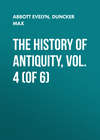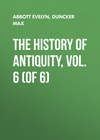Читать книгу: «The History of Antiquity, Vol. 4 (of 6)», страница 28
The companions of Alexander tell us that among some Indians widows voluntarily burnt themselves with the corpses of their husbands, and those who did not do this were in no esteem.749 Among the Indians, says Nicolaus of Damascus, the favourite wife was burnt with the dead husband. The wives contended for this mark of honour with the greatest eagerness, and each was supported by her friends.750 The captain of the Indians who with Eudemus attacked the army of Eumenes (p. 442) – the Greeks call him Ceteus – fell in the battle, which took place between Eumenes and Antigonus in Parætacene in the year 316 B.C. The two wives of Ceteus had accompanied him to the field and now contended for the honour of being burnt with him, since the law of the Indians, as Diodorus observes, allowed one wife only to be so burnt. The younger of the two maintained that the elder was pregnant; the elder declared that precedence in years carried precedence in honour. When the pregnancy of the elder had been established, the captains of the army decided that the younger was to ascend the pyre. "Then the elder took the diadem from her head, tore her hair and cried aloud, as though she had met with a great misfortune, while the younger, rejoicing in her victory, went to the funeral pile, crowned and adorned as if for marriage, accompanied by her women, who sang a hymn. When she approached the pyre, she divided her ornaments among her relations, servants, and friends, as memorials of herself: a number of rings set with precious stones of various colours, gold stars with brilliant stones from her head-dress, and a great quantity of necklaces, large and small. When she had bidden farewell to her relations and servants, her brother conducted her to the pyre; she bowed herself before the corpse of her husband, and when the flames blazed up she uttered no sound of lamentation. In such a heroic manner did she end her life, and moved all who saw her death to sympathy or admiration."751 Western accounts from the first century B.C. and later times represent the burning of widows as an established custom.752
We are acquainted with the hymns of the Rigveda in which the widow, when she has led her husband to the place of burial, is exhorted to "elevate herself to the world of life," for her marriage is at an end; we know the rule in the law that a widow should not marry again after the death of her husband; if she did so, she would fall into disrepute in this world, and in the next be excluded from the abode of her husband. She must live alone, avoid all sensual pleasure, starve herself, and do acts of piety, then after her death she would ascend to heaven. Neither the sutras of the Buddhists nor the Brahmanas mention the burning of widows. On the other hand, in the Mahabharata the two wives of Pandu, Kunti and Madri, contend after his death precisely as the two wives of Ceteus, which is to ascend the pyre. Kunti founds her claims on the fact that she had been the wife of Pandu before Madri, and his first queen; Madri asserts that Pandu had loved her more than Kunti, that she had been his favourite wife. The Brahmans decide that Madri is to go. In the Ramayana the burial of king Daçaratha is described in great detail, but none of his wives, neither Kauçalya, nor Kaikeyi, nor Sumitra is burnt with him. In other passages also the Epos speaks of widowed queens with all honour. If, then, the Epos of the Indians, even in the form in which we have it, wavers about the custom of the cremation of widows, and on the other hand the Greeks assert and prove the existence of the custom in the last thirty years of the fourth century B.C., we may assume that the sacrifice of widows came into practice in the course of the fourth century B.C. in connection with the increase in the requirements of self-annihilation, of which we have just read. It was, no doubt, the consequence derived from the unconditional dependence of the wife on the husband, required by the Indians, and the command to bear any fortune joyfully together with the husband, of that extreme wifely love and devotion, of which we have found touching examples in the Epos. From the idea of self-annihilation, which was the summit of all good actions, the Brahmans might arrive at the demand that women also ought in certain cases to practise such annihilation; that a widow must sacrifice herself on the pyre of her husband as an offering for his sins. This is never stated as a law, but at a subsequent time the demand of the Brahmans obtained general observance and recognition, supported as it was by the doctrine that only the widow, who burnt herself with the corpse of her husband, found an entrance into the better world. According to the rules, which have come down to us from a later time, the widow of the Dvija, when she had bathed and anointed herself, coloured herself with sandal wood, and put on her ornaments, more especially her jewels, with butter, kuça-grass, and sesame in her hands, offered a prayer to all the gods, with the reflection that her life was nothing, that her lord was her all. Then she walks round the pyre, gives her jewels to the Brahmans, comforts her relatives, and bids farewell to her friends. Afterwards she says: "That I may enjoy the happiness of heaven with my husband and purify my ancestors and his I ascend the pyre in expiation of the sins of my husband, even though he has murdered a Brahman, torn asunder the bonds of gratitude, or slain a friend. On you I call, ye eight protectors of the world (p. 160), as witnesses of this action, ye sun and moon, air, fire, earth, æther, and water. Be witnesses, my own soul and conscience, and thou, Yama, Day and Night, and Ushas, be ye witnesses, be witnesses! I follow the corpse of my husband to the burning pyre." Then the widow ascends the pile of wood, which must be kindled by her son or her nearest relation, embraces the corpse of her husband, with the words, I pray, adoration, and commits herself to the flames, crying Satya, Satya, Satya.753
In opposition to Buddhism, the chief point was not only to keep the hearts of the people true to the Brahmanic arrangement of life by the adoption and exaltation of the deities to which their religious feeling was directed; at the same time a counterpoise must be provided to the speculation and scepticism of the Buddhists; they must be met by an orthodox system of philosophy. The question was, whether the existence of the individual soul beside nature, on which the Sankhya doctrine no less than Buddha laid such stress, was incompatible with the idea of Brahman; whether death without regeneration, the highest good and supreme object of the Buddhists, could not be shown to be attainable by the fulfilment of the duties prescribed by the Brahmans, by Brahmanic speculation and meditation. These were the questions which a new system, the Yoga, sought to solve. The author of this is said by the Indians to be Yajnavalkya, whose life is placed in the fourth century B.C. The oldest form in which the principles of this new system are known to us does not go back beyond the year 300 B.C.754 He attempts to fix the idea of the world-soul or Brahman more clearly than had been done in earlier theories. This soul is now regarded as present everywhere in the world, but also as existing for itself. In opposition to the Sankhya and the Buddhists the separate existences and souls of men could be now explained as something more than parts of Brahman; their individual existence must be conceded, and proof given that they were still parts of Brahman. This system therefore teaches us: whatever gives to each thing its leading characteristic or quality, that is the world-soul in it. But though this living world-soul is divided into all creatures and exists in all, it must nevertheless be one and therefore indivisible. In opposition to heterodox systems Brahmanic speculation was no longer bold enough to deny entirely the existence of matter, and to explain it as appearance or deception; on the contrary, it now borrows from the Sankya doctrine the dogma of the eternity of matter. Matter is no less eternal than the world-soul. It is true that it changes, but it is not destroyed; the destruction of matter is only a change, in which a new birth follows on apparent decay. It is allowed that the souls of men which proceed out of Brahman, "as sparks out of a piece of hot iron," exist independently; when one is worn out they perpetually provide themselves with a new body, a new garment, for the souls and the elements, i. e. nature, are real;755 but since these souls proceed from the divinity they can go back to the world-soul.
In this we find an unmistakable attempt to harmonise the old Brahmanic system with the axioms of the Buddhist theory, the Buddhist principles of the permanent existence of the soul with the theory of the world-soul. The essential question was a practical one; how this new theory of the Brahmans would bring about the liberation from regeneration, which Buddha realised in the last instance by the extinction of the ground of existence in the soul, of desire. Like the Buddhists it assumed the eternal change, the restless revolution of birth and decay; it naturally maintained the old Brahmanic position that the soul is followed by its actions into another world; that by these the new births were fixed; what means did it provide for an escape from this revolution? Like the Buddhists it taught that only the knowledge of the true connection of things can lead to liberation. But the spirit furnished with immature instruments is as incapable of knowledge as an unclean mirror is incapable of reflecting forms. By subduing the senses, removing passions, avoiding love or hate, by purifying the mind, the instruments of knowledge must be sharpened. As the soul is infected with matter, the requirements of nature must be satisfied with moderation; as man is in the world, he must fulfil the duties which fall to every man in the order of the world. He must act, but in such a manner as if he were not acting; he must be indifferent to the results of the action, and acquire freedom from doubleness, i. e. from the prosperous or unfortunate result. Filled with darkness and passion man is driven round like a wheel. Truth, which consists in "casting aside the net of folly," liberates men, and the net is cast aside by distinguishing between the cognitive faculty and nature or change.756 As the æther, though isolated in various jars, is still one, so is the spirit at the same time one and many, just as the sun is reflected in various masses of water.757 The being who dwells like a lamp in the heart has beams innumerable; from this one darts upward, piercing the sun's disk, to the world of Brahman. With eyes closed in repose, with veiled face avoiding every charm of the senses, holding in check his appetites, on a scale neither too high nor too low, let him who has brought to perfection the instruments of knowledge, and purified his spirit, who will find truth, hold his breath twice or thrice. Then let him think on the lord who is the lamp in his heart, and with all his heart keep his mind fixed on this. Meditation is brought about by the realisation of true being. The symbol of the perfection of meditation is the power to create and disappear, to leave one's own body and enter another. He whose spirit at the dissolution of his body is firmly fixed in the truth in regard to the lord, whose conviction remains unshaken, attains to the remembrance of his births, and he who leaves the body in complete meditation (yoga) becomes an inhabitant of Brahman's world; there is no return for him; he is never born again.758
Thus in the place of the annihilation of the body and consciousness required by the old system, in the place of the extinction of the Ego by the annihilation of its basis taught by the Buddhists, the new speculation of the Brahmans puts the mystical union of the Ego with the Supreme by meditation, by elevation and concentration of the spirit, when the path has been prepared for such union by retirement from the world, by the removal of the passions, and conquest over the appetites. The fruits of this act of union with the god-head are in the first instance the same supernatural powers which the Buddhists ascribed to the Arhat, the man "advanced in the path" (p. 472), and finally the freedom from regeneration, the highest object of all.
More important than the speculation which founded this new way to liberation were the practical consequences, the ethical rules which resulted from this theory of the Brahmans. It was now possible to identify Vishnu or Çiva with Brahman. If a certain attitude of the soul, an inward deed, an act of the spirit, meditation, was the highest aim, the first place could no longer be ascribed to sacrifice, penance, and asceticism. The order of the world ascribed to the creator, the rights and duties of the castes, could not be altered in any way; the castes were still special emanations and forms of the Supreme. Even sacrifice is still to be offered, expiations and penances are to be observed. But their effects must not be over-estimated. The exclusive value ascribed to them, so the new theory maintains, is exaggerated, as is the reward which men promise themselves from such works.759 In reality, the wise man ought only to perform them in order not to deceive the people. He must do the works by which the ancient sages attained perfection, and fulfil all ceremonies for the edification of men. The people would become corrupt if they performed no pious works, the castes would be mixed, creatures thrown into confusion.760 Thus in reality the new system maintains works simply because the position of the Brahmans, the order of the castes, cannot be tampered with or overthrown. But at the same time asceticism is essentially softened, and an approach made to the milder Buddhist form of it. It is a proof of incomplete knowledge to starve oneself, pass into fire, or plunge into water.761 No doubt the Dvija in his later years ought to go into the forest accompanied by his wife, or when he has left her in the charge of his sons, and there practise the prescribed exercises.762 But the anchorite's life is not the cause of virtue, and those who seek salvation by gifts, sacrifice, and penances do indeed attain to the heaven of the fathers, but they return to this world.763 If the Yoga, by ascribing this position to penance, approaches the doctrine of Buddha, the same is done in a still higher degree in the rules of its ethics. Here the new Brahmanic teaching is wholly in harmony with the Buddhists; it requires gentleness and kindness to all creatures, truthfulness, control of the appetites; it forbids theft and hatred: that is the sum of virtue. Nevertheless, the greatest concession made to Buddhism lies in the removal of the boundary which had been set up in regard to religion between the Dvija and the Çudra. It is true that neither all the castes nor all men are permitted in the Yoga, as they are in Buddhism, to find salvation and liberation. But the Çudras are no longer excluded as hitherto from the Veda and the worship; they too may learn the Veda,764 and in the Bhagavad-gita it is openly stated that even the Çudra may attain the highest point.765
The principles of the new doctrine appeared so important to the circles of the Brahmans, to which they owed their origin and observance, that they attempted to obtain recognition for them among princes and people by a new book of the law. This book originated in Mithala (Tirhat), and like the Yoga bears the name of Yajnavalkya. Setting aside the worship of the deities of the planets – star-worship came into vogue after the sixth century B.C. – and the rules for asceticism, ethics, and the way of salvation, the new book is distinguished from the old by its compressed compendious form, and by the clearer composition of the separate rules. Its regulations for trade and conduct are more detailed than in the book of Manu. If the latter mentions written stipulations, the new speaks of the preparation of documents on metal plates. The modes of the divine judgments are increased,766 and gambling-houses are permitted. All the rules for purity, expiations, and penance given in the older book are repeated with the restrictions given above, that they have beneficial results, but do not exclude regenerations, and that penance must not be carried to the point of self-annihilation. The duties of the monarchy are given accurately according to the old law; the arrangement of the castes and the ancient law of marriage are retained, with the advantages, privileges, and exemptions of the Brahmans. Some new subordinate and mixed castes are added. The opposition to the Buddhists is vigorously expressed, and mention is made of men with shorn heads and yellow garments.767 The kings are required to erect buildings in the cities and put Brahmans in them to form societies for the study of the Veda; these the king is to support with the exhortation that they must fulfil their duties.768 Hence it appears that the Brahmans considered it advisable to erect Brahmanic monasteries in opposition to the viharas of the Buddhists, and to support them at the cost of the state.
CHAPTER IX.
AÇOKA OF MAGADHA
The Brahmans had reason to expect favourable effects from the changes they had made in their doctrine and ethics. They had taken account of the desire for the worship of more real and living deities, and in order to satisfy this they had pushed Brahman into the background; they were zealous in giving tangible shape to the benefits which their deities had bestowed upon men; they ascribed the best results to pilgrimages, and if on the one hand they intensified the merits and efficacy of penance, they allowed on the other hand the merit of works to fall into the background, and moderated asceticism. They sought to reconcile the elements of Buddhist speculation with their ancient system, and increased the circle of the men admitted to salvation. In the Yoga they had as a fact found a deeper solution of the problem of the liberation of the Individual than Buddha had pointed out in his doctrine. Then it happened that so far from obtaining the assistance and support from the state which the new law claimed, the power of the throne which ruled all India ranged itself on the opposite side.
As we have seen, Chandragupta's great kingdom was maintained in its full extent by his son Vindusara, and the relations to the West became more extensive under his reign. When Vindusara was in his last sickness, his son Açoka, the viceroy of Ujjayini, hastened to Palibothra, as the Buddhists inform us, possessed himself of the throne, and caused his brothers to be put to death, with the exception of one born from the same mother as himself.769 Like his father Vindusara, he daily fed 60,000 Brahmans, ruled with a severe and cruel hand, and himself carried out the execution of those who had incurred his anger. After three years of this savage conduct he was converted, according to the account of the Singhalese, by Nigrodha the son of Sumana, one of the brothers murdered by him, to whom the Sthaviras had granted the initiation of the novice (p. 465). According to the account of the northern Buddhists, a Buddhist Samudra, a merchant of Çravasti, who had come to Palibothra, was thrown at Açoka's order into a vessel full of boiling fat and water. Samudra felt no pain, and when the fire under the kettle could not be kindled by any means, the king was summoned to see the marvel. This sight and Samudra's exhortation converted the king to Buddhism. Açoka entreated the holy man to forgive him his sinful acts, took his refuge in the law of the Enlightened, and promised to fill the earth with Chaityas (monuments) in honour of Buddha. He caused a large monastery, the Açokarama-Vihara, to be built for the Bhikshus at Palibothra,770 and instructed his viceroys to erect viharas in all his cities. The relics of Buddha, which had been divided after his death and placed in eight monuments (p. 365), Açoka caused to be taken away; only the part which the Koçalas had received from Ramagrama and concealed there, remained untouched. The other relics of the Enlightened were divided into 84,000 parts, and placed in cases of gold, silver, crystal, and lapis-lazuli, so that each of the great, middle-sized, and small cities in the kingdom of Açoka might receive a relic of Buddha. In order to preserve these, 84,000 stupas, i. e. domes with coverings over them, together with as many viharas, were built at Açoka's command.771 Thus the king adorned the surface of the earth with beautiful stupas, which were like the summits of the mountains, and furnished them with precious stones, parasols, and standards,772 and travelled to every place where Buddha had stayed and preached, and announced his determination to honour these places also by monuments. In all the cities of the kingdom the law of the Enlightened was proclaimed in the name of the king;773 the son of the king, Mahendra, and his daughter Sanghamitra, who was born to him before his accession to the throne, renounced the world and received the consecration of the mendicant, the son in the twentieth, the daughter in the eighteenth year of her age; even Tishya, the brother of Açoka, who alone had been spared, became a Bhikshu, and entered the Açokarama.774
As errors had crept in and the true law was not observed everywhere in the viharas, the king took the advice of the Sthavira Maudgaliputra,775 sat on the same seat with him, and assembled in council the orthodox and heterodox Bhikshus. When the purity of the sacred law had again been established by the assembly, Maudgaliputra perceived that the time had come to spread abroad the doctrine of the Enlightened. He sent the Sthavira Mahadeva into the land of Mahisha (a region on the Narmada);776 Mahadharmarakshita into the land of Maharashtra (the upper Godavari); Dharmarakshita into the land of Aparantaka,777 Çona and Uttara into the gold-district of Suvarnabhumi; Madhyama and Kaçyapa into the Himavat; and Madhyantika into the land of Cashmere and the Gandharas. Mahendra, the king's son, set out in person to preach the good law in Lanka, when Açoka had explained to the envoys, whom Devanampriya-Tishya, the king of Lanka, had sent to him at Palibothra, that the king might enlighten his spirit and seek refuge with the best means of salvation, even as he (Açoka) had sought refuge with Buddha and the Dharma (law) and the Sangha (community). When Mahendra arrived at Ceylon, Devanampriya-Tishya received him hospitably, gave him the garden of Mahamegha near the metropolis Anuradhapura for a habitation, and there built him a vihara.778 He converted the inhabitants of Lanka by thousands. At his request Açoka sent him the alms-jar of Buddha, and his right shoulder bone, which the king of Lanka deposited in a stupa, built on Mount Missaka, near Anuradhapura, and Mahendra's sister Sanghamitra followed her brother to Lanka with eleven other initiated women, in order to convey there a branch of the sacred fig-tree of Gaya, under which enlightenment was vouchsafed to Buddha (p. 339). Mahendra received five hundred Kshatriyas of the island into the sacred order; Sanghamitra initiated five hundred maidens and as many women of the royal palace as mendicants; and when the branch was planted in the soil of the garden of Mahamegha, it grew up into a great tree. Açoka daily supported 60,000 Bhikshus by alms,779 and during the rainy season, 300,000 religious persons and novices; and gave all his treasures, his ministers, his kingdom, his wives, and finally himself to the assembly of the Aryas.780
Such is the account of Açoka given in the tradition of the Buddhists. We can establish the fact that he succeeded his father on the throne of Magadha in the year 263 B.C. and retained it till 226 B.C.781 His inscriptions, the oldest which have come down to us, enable us to test more closely the narration of the Buddhists, who had every reason to honour the memory of the great king, who became a convert to their religion, and gave it a pre-eminent position throughout his vast empire. Both in the neighbourhood of the modern Peshawur, at Kapur-i-Giri, to the north of Cabul, and near Girnar (Girinagara) on the peninsula of Guzerat, and on the rocks of Dhauli in the neighbourhood of Bhuvaneçvara, the metropolis of Orissa, near Khalsi on the right bank of the Yamuna, at Delhi (the ancient Indraprastha), at Allahabad, Bakhra, and Bhabra in the neighbourhood of the ancient Palibothra, the modern Patna, and finally at Mathiah and Radhya,782 in the valley of the upper Gandaki on the borders of Nepal, we find inscriptions of this king. Some are hewn in the rocks, others engraved on separate monolithic pillars, about forty feet in height; pillars of the law they are called by him who erected them. Carefully rounded and smoothed they carry above the capital of beautiful pendent lotus leaves, on a square slab, lions of excellent execution, without doubt the symbol of the lion of the tribe of the Çakyas, of Çakyasinha, Buddha. Two pillars of this kind, the one entire the other broken, are at Delhi; the other four are at Allahabad, Bakhra, Mathiah, and Radhya. If Açoka caused inscriptions to be engraved at Peshawur, beyond the Indus, the regions which Seleucus had given up to Chandragupta must have been retained by Vindusara and Açoka. The inscriptions on the peninsula of Guzerat (they speak of buildings at Çirinagara which Açoka had caused to be erected there by his viceroy Tuhuspa),783 and those at Bhuvaneçvara, on the mouths of the Mahanadi, as well as those on the borders of Nepal, prove that Açoka's dominion reached from the Himalayas to the mouths of the Narmada and Mahanadi. According to the tradition of Cashmere Açoka reigned over that land also, extended the metropolis, Çirinagara, built two palaces there, caused a lofty Chaitya to be erected, and covered Mount Çushkala near Çirinagara with stupas.784 The inscriptions of Açoka himself inform us that he carried on war against the land of Kalinga in the south of Orissa, on the lower course of the Godavari (p. 410), and subjugated the inhabitants to his power;785 and that he ruled over the Gandharas, Cambojas and Yamunas, the Rashtrikas and the Petenikas. Under the name of Cambojas are comprised the Aryas on the right bank of the Indus. To the south as far down as the Cabul, the Yavanas are evidently the Greeks, with whom Alexander had peopled the three cities called after him, which he founded in Arachosia (on the Arghandab and the Turnuk, where the modern Kandahar and Ghazna stand), and on the southern slope of the Hindu Kush at the entrance of the path leading to the north into Bactria.786 The Rashtrikas are the inhabitants of the coast of Guzerat, the Petenikas are the inhabitants of the city and land of Paithana on the upper Godavari.787 Hence the dominion of Açoka extended from Kandahar, Ghazna, and the Hindu Kush, as far as the mouth of the Ganges, from Cashmere down to the upper and lower course of the Godavari.
According to his inscriptions the influence of Açoka extended even beyond these wide limits. At the boundaries of the earth, so we are told, were to be found the two cures established by him, the cure for men and the cure for animals. Wherever healing herbs, roots, and fruit trees were not in existence, they were brought and planted by his order, and wells were dug by the wayside. This was done among the Cholas and Pidas, in the kingdom of Keralaputra, and on Tamraparni (Ceylon). Even Antiyaka, the king of the Yavanas, and four other kings, Turamaya, Antigona, Maga, and Alissanda, "had followed the precept of the king beloved of heaven," i. e. of Açoka.788 The Cholas and Pidas lay to the south of the Deccan, the former on the upper Krishna, the latter on the Palaru. Keralaputra, i. e. son of Kerala,789 is the ruler of the state founded by Brahmans on the southern half of the Malabar coast (p. 368). It is clear from this, no less than from the conquest of Kalinga by Açoka, how successful in the times of the earliest rulers of the house of the Mauryas, was the power of Arian India collected in that kingdom in forcing its way to the south, both on the coasts and in the interior of the Deccan; and at the same time these inscriptions confirm the statements of Singhalese tradition about the connection in which Açoka stood with this island. They also show us that Açoka not only maintained but extended the relations into which his grandfather had entered with the kingdom of the Seleucidæ, and his father with the kingdom of the Ptolemies. Açoka is not only in connection with Antiyaka, i. e. with his neighbour Antiochus, who sat on the throne from 262 to 247 B.C., and with Turamaya, i. e. with Ptolemy Philadelphus of Egypt (285-246 B.C.), but also with Antigonus Gonnatas of Macedonia (278-258 B.C.), with Alissanda, i. e. Alexander of Epirus (272-258 B.C.), and even with Magas, king of Cyrene. The Seleucidæ, it is true, had reason to keep on a good footing with the powerful king of India; and the Ptolemies took a lively interest in the trade of India and Egypt. But the kings of Macedonia, Epirus, and Cyrene were unconcerned with such matters. It is mere oriental extravagance that Açoka causes these princes to obey his commands, though the fact that Açoka is acquainted with Epirus and Cyrene shows how greatly the horizon of the Indians had extended since the time that Alexander trod the Panjab. Not merely were these lands of the distant west known, Açoka was in connection with them. Ambassadors were sent to their princes and are said to have received the assurance that no hindrance would be placed in the way of the preaching of the doctrine of Buddha.790
The inscriptions of Açoka contradict the tradition which represents him as becoming a convert to the doctrine of Buddha in the third year of his reign. It is possible that he may have shown himself favourable to the Buddhists a few years after his accession; but it is clear from the inscriptions at Delhi that he did not openly profess their doctrine till after long consideration, and the inscriptions at Girnar inform us that he took this step in the tenth year after his consecration, i. e. no doubt, after his accession, consequently in the year 254 B.C., and that he did not take it without special regard to the ancient religion and the Brahmans. The king, we are told in that inscription, was no longer given up to the chase of animals, but to the chase of the law, to making presents to Brahmans and Çramanas, to searching out and proclaiming the law. This conversion is said to have been announced by sound of drum, with trains of festal cars, elephants, and fires; many divine forms were also displayed to the people.791 In an edict published two years later Açoka gives command that in the kingdom which he has conquered and the territories in union with him assemblies shall be held in every fifth year, at which the laws are to be read and explained: obedience to father and mother, liberality to the nearest relations and friends, to Brahmans and Çramanas, economy, avoidance of calumny and the slaying of any living creature; after this confessions were to be made.792 These are, as we have seen, the fundamental ethical rules of the Enlightened. In Buddha's doctrine good actions come from the feelings and heart; the right feeling of the heart is to show sympathy and pity to all living creatures, and to alleviate their lot. This precept also Açoka was at pains to fulfil; in all his inscriptions he calls himself not Açoka but Devanampraiya Priyadarçin, i. e. the man of loving spirit beloved by the gods.
Покупайте книги и получайте бонусы в Литрес, Читай-городе и Буквоеде.
Участвовать в бонусной программе


















